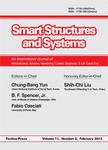版权所有:内蒙古大学图书馆 技术提供:维普资讯• 智图
内蒙古自治区呼和浩特市赛罕区大学西街235号 邮编: 010021

作者机构:Nanyang Technol Univ Sch Civil & Environm Engn Singapore 639798 Singapore Nanyang Technol Univ Sch Elect & Elect Engn Singapore 639798 Singapore
出 版 物:《SMART STRUCTURES AND SYSTEMS》 (智能结构与系统)
年 卷 期:2010年第6卷第7期
页 面:767-792页
核心收录:
学科分类:08[工学] 0804[工学-仪器科学与技术] 0802[工学-机械工程] 0813[工学-建筑学] 0814[工学-土木工程]
主 题:optimization vibration control sequential quadratic programming smart structures
摘 要:In this paper, the optimal design of vibration control system for smart structures has been investigated semi-analytically via the optimization of geometric parameters like the placements and sizes of piezoelectric sensors and actuators (S/As) bonded on the structures. The criterion based on the maximization of energy dissipation was adopted for the optimization of the control system. Based on the sensing and actuating equations, the total energy stored in the system which is used as the objective function was analytically derived with design variables explicitly presented. Two cases of single and combined vibration modes were addressed for a simply supported beam and a simply supported cylindrical shell. For single vibration mode, the optimal distributions of the piezoelectric S/As could be obtained analytically. However, the Sequential Quadratic Programming (SQP) method has to be employed to solve those which violated the prescribed constraints and to solve the case of combined vibration modes. The results of three examples, which include a simply supported beam, a simply supported cylindrical shell and a simply supported plate, showed good agreement with those obtained by the Genetic Algorithm (GA) method. Moreover, in comparison with the GA method, the proposed method is more effective in obtaining better optimization results and is much more efficient in terms of computation time.